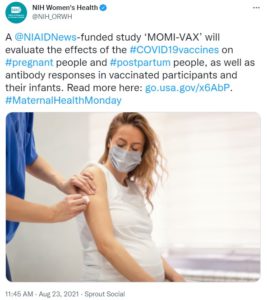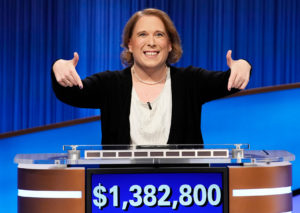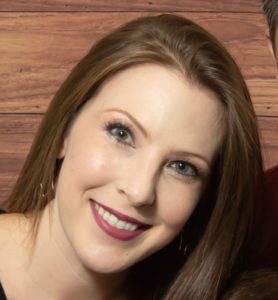“What is a woman? Can you tell me what a woman is?” (Matt)
“No, I can’t- because it’s not for me to say. Womanhood looks different for everybody.” (Ethan)
“Womanhood is- just as Ethan explained- something I cannot define because I am not myself…I do not define what a woman is because I do not identify as a woman. Womanhood is an umbrella term.” (Addison)
“…That describes what?” (Matt)
“…People who identify as a woman.” (Addison)

This conversation now famously took place on the Dr. Phil show in January between Matt Walsh (a conservative pundit) and two non-binary transgender advocates, Ethan Alexander and Addison Rose Vincent- and it caused quite a firestorm. While Walsh wasn’t the first person to force this question, he did it more effectively than it is often done because he managed to elicit an answer.

The question was again brought to the forefront when author J.K. Rowling made the news for challenging Anneliese Dodds, the equalities minister for the British Labour Party. Dodds recently refused to define what a “woman” is, saying, “I’m avoiding going down rabbit holes…there are different definitions legally around what a woman actually is.” She then went on to say that the meaning of the word depended on “context.”
It’s not just Dr. Phil’s guests or one British MP who can’t or won’t define what a woman is. This is increasingly common. Seemingly going hand in hand with our difficulty defining the word “woman” is our difficulty saying it. In 2021, the White House’s fiscal year budget replaced the word “mothers” with “birthing people,” sparking an outcry, and the administration has often been heard using a similar phrase when discussing expectant mothers- “pregnant people.” This phrase is also becoming extremely common on medical sites and women’s health platforms on social media. As a pro-life advocate, I often “run into” pro-abortion advocates on social media who will not use any other phrase and who no longer use the term “woman” in that context.
So how can we decide major cultural and legal questions if we don’t have a common definition for what a woman is and if we don’t agree on when and how to even use the word?
Obvious areas in which we need to reach agreement on these issues are: women’s locker rooms, women’s restrooms, women’s sports teams, and women’s awards and accolades. Very few people are concerned with transgender people who were born female participating in men’s sports or entering male spaces. This is because these people are no physical threat to men in bathrooms or locker rooms (in fact, they are the ones at greater risk) and because they have no physical advantage in sports (in fact, they have a disadvantage). The concern is exclusively about people who were born male sharing private female spaces and winning titles that were created to give women opportunities to thrive in a world that hasn’t always given females those chances.

Just in the past few months we’ve witnessed 1.) Rachel Levine named as one of USA today’s Women of the Year 2.) Amy Schneider lauded as the “most successful woman in history” on Jeopardy, and most controversially 3.) Lia Thomas win the NCAA Division 1 championship in Women’s swimming.

If our working definition is simply, “People who identify as a woman” as Addison Rose Vincent claims, then nobody should have any problem with any of these accolades or wins, and yet many people do- on both sides of the aisle. In fact, current Gallup polling suggests that despite overwhelming support from the highest politicians in the Democratic Party, key cultural groups like the ACLU, and even organizations like the Women’s March, the majority of Americans of all political persuasions DO NOT agree with transgender athletes who were born male competing in women’s sports categories. Only 34% of all respondents were in favor.
In order to wade through all of this, we have to establish which is ascendant- identity or biology. Many transgender allies and advocates will make the case that sex and gender are different. They will concede the point that someone can be born male or female, but they claim that biology does not determine gender, which they describe as a social construct. There are often a whole host of contradictions to this claim (such as altered birth certificates, which were obviously never designed to describe gender identity but rather biological sex), but that is the claim nonetheless.
I don’t think that distinction is even important to debate in most of these cases. Putting aside that truth claim for a moment- because as MP Dodds points out, it really IS a rabbit hole- I would just like to point out why gender as a social construct isn’t really the issue at hand here. Biological sex is really what is in question for most of our public policy- not gender identity.

For example, when we say that women’s sports are for “women” or “females,” of course we historically meant biological females with physical disadvantages compared to males in sports. While some women can beat men in any given sport, there is no sport where the best men do not beat the best women. For example, Lia Thomas (formerly William Thomas) ranked 554th in the men’s category but just defeated two female Olympic silver medalists for the title of NCAA champion- even after a year of receiving female hormones. Thomas beat the runner-up by almost 2 full seconds. The biological advantages that people with male bodies have over those with female bodies at the highest level of athletics is clear. That doesn’t mean Lia will win every time or that every trans athlete is better than every biologically female athlete- just that they have an advantage which would make it more possible to do so and which- if the athlete is good enough- a biological female COULD NOT overcome.
Women’s sports were historically either nonexistent or at a huge disadvantage. It wasn’t until Title IX of the Education Amendments Act of 1972 that women’s athletic programs comprised more than 2% of college athletic budgets. Women needed a huge boost to even get the recognition to compete, let alone the opportunities.
This was not necessary because women had a different identity than men. Women weren’t segregated in order to feel unique or womanly. Separate categories were created to allow women to enter the game, to keep them safe, and to give them a chance to win against each other when they couldn’t win against equivalently talented biological men. After 1972, this effort was infused with life. It gave women chances to excel and advance- even economically- through sponsorships and titles. For these reasons, the definition of “woman” in sports needs a better explanation than someone who “identifies as female” and whose hormones have been suppressed or altered for “X amount” of months.
 We also did not segregate bathrooms for identity reasons. We did it for biological reasons- for women’s safety and privacy. Since men do not menstruate, they cannot understand that privacy necessary to that biological function, but it is certainly a factor. That is not an issue of identity, but of physical autonomy and comfort. Even more importantly, because of the historical violence against women, private spaces are critical.
We also did not segregate bathrooms for identity reasons. We did it for biological reasons- for women’s safety and privacy. Since men do not menstruate, they cannot understand that privacy necessary to that biological function, but it is certainly a factor. That is not an issue of identity, but of physical autonomy and comfort. Even more importantly, because of the historical violence against women, private spaces are critical.
It is important to point out that every person struggling with this identity is not bent on aggression or violence (and no doubt most are not), but it’s not each individual’s personal heart that is in question. I have used a restroom with a person who was clearly transgender (and very possibly many other times I was not aware of), and no harm came to me. I was also not scared- but then again there were multiple women in the restroom. I may have felt differently if I was alone and did not know the current anatomy or physical capabilities of the other person present. The issue is not any one individual- it is the inequity of a woman alone in a secluded bathroom with a person who very possibly has a penis.
Men cannot and will not ever know this fear on the consistent basis that women do. While men can be assaulted (and I am well aware that transgender people are assaulted at a higher rate than average men), they do not face the consistent danger women do by virtue of their more vulnerable size and anatomy. It is “privilege” at its highest for men to tell women what risks they must take and what fears they must ignore in order to validate another’s feelings about identity.
At the end of the day, people can identify as whatever and whomever they want. That doesn’t mean that all laws should automatically reflect that identification or that all people should have to alter their own spaces to affirm it. This is even more true when those spaces were created for safety or equity in the first place. In this gender debate, I think it is extremely important that we don’t conflate identity and biology. It is also of the utmost significance that we have a clear and common understanding of what we mean when we use the word “woman” and of what extra protections that title confers in our public spaces and in our athletic arenas.
While to many the word “woman” may be rooted in their identity, it is also a biological definition, and it should not be used interchangeably with no clarification. When biology is the question on the table (as in cases of safety, sports, etc.) then biology needs to be honestly handled as a straightforward part of the discussion. To silence opposition with phrases like, “She is a woman because she told you she is a woman” is unscientific and results in the intimidation of any biological woman who asks questions.
I know my words will be hurtful to anyone who identifies as transgender, and that was not my intention. In fact, I would like to appeal to them to take my points and consider whether they can find it in their hearts to forego certain public expressions of gender that might compromise biological women. I request that they consider putting themselves second in these cases in order to protect women’s spaces, institutions, athletic careers, and opportunities.
I’ll end my thoughts by leaving the last line blank for you, the reader. Fill it in to help you clarify your own definition.
A woman is:
_______________________________________
Thanks for reading, and don't forget to Click here to Subscribe!
About the Author

|
Jackie Chea is a blogger from San Antonio, Texas who holds a B.A. in Psychology and an M.A. in Community Counseling from the University of Texas at San Antonio. She writes on political and cultural issues from a conservative, religious standpoint. She lives in the Lone Star State with her husband, Nick, and their 7-year-old son, Lincoln. |


Facebook Comments